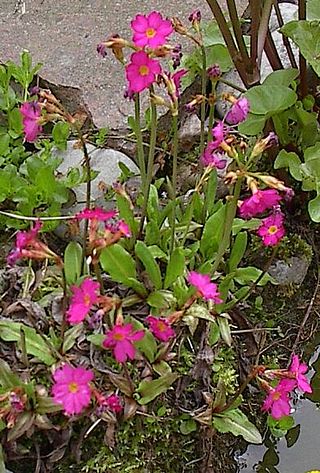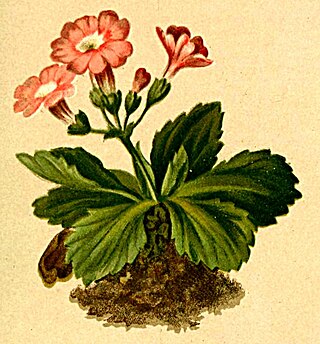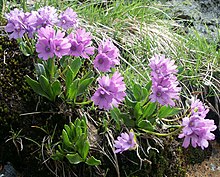
Iris is a flowering plant genus of 310 accepted species with showy flowers. As well as being the scientific name, iris is also widely used as a common name for all Iris species, as well as some belonging to other closely related genera. A common name for some species is flags, while the plants of the subgenus Scorpiris are widely known as junos, particularly in horticulture. It is a popular garden flower.

Primula is a genus of herbaceous flowering plants in the family Primulaceae. They include the primrose, a familiar wildflower of banks and verges. Other common species are P. auricula (auricula), P. veris (cowslip), and P. elatior (oxlip). These species and many others are valued for their ornamental flowers. They have been extensively cultivated and hybridised. Primula are native to the temperate Northern Hemisphere, south into tropical mountains in Ethiopia, Indonesia, and New Guinea, and in temperate southern South America. Almost half of the known species are from the Himalayas.

Alnus glutinosa, the common alder, black alder, European alder, European black alder, or just alder, is a species of tree in the family Betulaceae, native to most of Europe, southwest Asia and northern Africa. It thrives in wet locations where its association with the bacterium Frankia alni enables it to grow in poor quality soils. It is a medium-sized, short-lived tree growing to a height of up to 30 metres (98 feet). It has short-stalked rounded leaves and separate male and female flowers in the form of catkins. The small, rounded fruits are cone-like and the seeds are dispersed by wind and water.

An alpine garden is a domestic or botanical garden, or more often a part of a larger garden, specializing in the collection and cultivation of alpine plants growing naturally at high altitudes around the world, such as in the Caucasus, Pyrenees, Rocky Mountains, Alps, Himalayas and Andes. It is one of the most common types of rock garden.

Primula veris, the cowslip, common cowslip, or cowslip primrose, is a herbaceous perennial flowering plant in the primrose family Primulaceae. The species is native throughout most of temperate Europe and western Asia, and although absent from more northerly areas including much of northwest Scotland, it reappears in northernmost Sutherland and Orkney and in Scandinavia. This species frequently hybridizes with other Primulas such as the common primrose Primula vulgaris to form false oxlip which is often confused with true oxlip, a much rarer plant.

Primula vulgaris, the common primrose, is a species of flowering plant in the family Primulaceae, native to western and southern Europe, northwest Africa, and parts of southwest Asia. The common name is primrose, or occasionally common primrose or English primrose to distinguish it from other Primula species also called primroses. None of these are closely related to the evening primroses.

Primula auricula, often known as auricula, mountain cowslip or bear's ear, is a species of flowering plant in the family Primulaceae, that grows on basic rocks in the mountain ranges of central Europe, including the western Alps, Jura Mountains, the Vosges, the Black Forest and the Tatra Mountains.

Leucadendron is a genus of about 80 species of flowering plants in the family Proteaceae, endemic to South Africa, where they are a prominent part of the fynbos ecoregion and vegetation type.

Pinguicula primuliflora, commonly known as the southern butterwort or primrose butterwort, is a species of carnivorous plant belonging to the genus Pinguicula. It is native to the southeastern United States. The typical variety forms a white flower in blooming. Like other butterworts, it has sticky adhesive leaves which attract, capture and digest arthropod prey in order to supply the plant with nutrients such as nitrogen not found in the nutrient poor, acidic soil that it grows in. Its name derives from the fact it is usually the first one to flower in the spring.

Primula deorum, also known as Rila primrose, Rila cowslip or God's cowslip, is a flowering dicot plant of the genus Primula in the family Primulaceae. This alpine plant is endemic to roughly 63 km2 above the tree-line in the Rila mountains in Bulgaria, where it grows in small groups in acid, boggy soil near streams and pools and in boggy soil. Its elongate green leaves form rosettes. The blooms are red-purple, borne in asymmetrical umbels high above the leaves. This plant has survived the last glacial period as a relict organism.

Primula rosea, the rosy primrose, is a flowering plant species in the genus Primula, native to the Himalayas. Growing to 50 cm (20 in) tall, it is a hardy herbaceous perennial with red-tinged leaves and clumps of rich pink flowers in spring.

Eucryphia glutinosa, the brush bush or nirrhe, is a species of flowering plant in the family Cunoniaceae, native to moist woodland habitats in Chile. It is a large deciduous shrub or small tree, growing to 10 m (33 ft) tall by 6 m (20 ft) wide, with glossy dark green leaves turning red in autumn. Single four-petalled, fragrant white flowers with prominent stamens appear in late summer.

Primula frondosa, the leafy primrose, is a species of flowering plant in the family Primulaceae, native to the Balkans. It inhabits shady spots in a small region of the central Balkan Mountains range in Bulgaria, where it is found at altitudes from 800 to 2,200 m. Its populations are situated within the boundaries of the Central Balkan National Park and the nature reserves Sokolna, Dzhendema and Stara Reka.

Androsace vitaliana is a species of plant in the primrose family, Primulaceae. It was previously known by the synonym Vitaliana primuliflora. Native to the high mountains of Europe, it is cultivated as an alpine garden plant, being considered easy to grow in well drained soil in a sunny position.

Primula angustifolia, also known as alpine primrose, is a species of flowering plant in the family Primulaceae, native to the Rocky Mountains of the United States. It is commonly found in Colorado and New Mexico.

Primula stricta, also known as the strict primrose, is a species of flowering plant in the family Primulaceae.
Primula aureata is a species of flowering plant from the family Primulaceae.

Primula daonensis is a species of Primula within the family Primulaceae.
Primula heucherifolia is a species of flowering plant in the family Primulaceae.
Primula boveana, also known as the Sinai primrose, is a species of flowering plant within the family Primulaceae. The species was named in honour of botanist and plant collector Nicolas Bové.
















